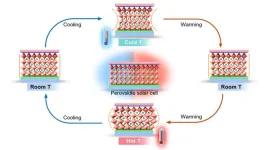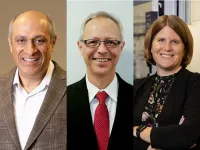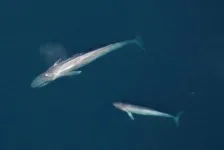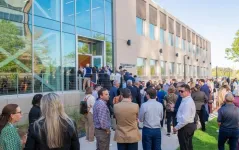(Press-News.org) Historically, access to geothermal energy has hinged on real estate’s famously three most important factors: location, location, and location. Because conventional geothermal power plants require hot, permeable rocks and plenty of underground fluid, use of the technology has been limited mostly to places with recent volcanism, such as Japan, New Zealand, the Philippines, Kenya, El Salvador, Iceland, and the western United States.
Over the past 50 years, however, techniques originally developed for oilfields and adapted for “enhanced geothermal systems” (EGS) have offered the promise of tapping deep reserves of natural heat across a broader swath of the planet.
“There is a lot of excitement about enhanced geothermal energy,” said Roland Horne, a professor of energy science and engineering in the Stanford Doerr School of Sustainability, who convened more than 450 engineers, scientists, and managers from 28 countries earlier this month at the 50th Stanford Geothermal Workshop to exchange ideas and report results from projects around the world.
To date, nearly all EGS applications have been for research purposes in one-off, small-scale plants, said Horne, who was invited to gather a team of authors to write a review paper for the February 2025 issue of Nature Reviews Clean Technology about EGS and its potential to supply energy at a larger scale.
Millennia after ancient Romans tapped subterranean heat to warm their buildings, and more than a century after Italy started up the world’s first geothermal power plant, Horne and co-authors note that geothermal today contributes as much as 45% of the electricity supply in some countries, like Kenya. But it still contributes less than half of 1% globally. Solar and wind contribute more than 25 times as much. With EGS, the potential now exists for geothermal to comprise a far greater share of humanity’s energy needs.
Faster drilling reduces costs
Many of the drilling techniques that enabled the shale gas boom of the early 2000s have been adapted to make geothermal work in more regions at lower cost, said Horne. These techniques include horizontal drilling and hydraulic fracturing, or fracking, which involves pumping fluids at high pressure into wells drilled down into and across rock formations thousands of feet underground. The pressure forces open existing fractures in the rock or creates new ones, easing the flow of petroleum or other fluids to the surface. In enhanced geothermal systems, the fluid is just hot water from the natural underground reservoirs.
Other adapted techniques include drilling multiple wells from a single pad to increase efficiency and reduce costs. Synthetic diamond drill bits, which can effectively chew through hard rock, have also proven critical, making it possible to complete a new geothermal well within a few weeks instead of months.
“Drilling faster makes an enormous difference to the whole economics of EGS,” said Horne, the Thomas Davies Barrow Professor at Stanford, who also serves on the scientific advisory board of an enhanced geothermal development company co-founded by Stanford alumni Tim Latimer, MS-MBA ’17, and Jack Norbeck, PhD ’16.
Based in part on modeling led by PhD student Mohammad Aljubran, Horne and his co-authors on the review paper estimate the faster drilling rates could make enhanced geothermal systems competitive with average electricity prices across much of the United States by 2027, at approximately $80 per megawatt-hour.
In California, which currently gets about 5% of its electricity from geothermal, the authors estimate geothermal capacity could increase tenfold with EGS to reach 40 gigawatts by 2045 and replace fossil fuels for baseload power. In this way, EGS would complement the intermittent renewables of wind and solar, adding stability to a decarbonized power grid.
“With EGS, we can meet the load,” said Horne, whose co-authors on the Jan. 31 review paper include Norbeck and former student Mark McClure, MS ’09, PhD ’12, the co-founder and chief executive of a company that markets fracture modeling software to oil, gas, and EGS companies. Additional co-authors include William Ellsworth, an emeritus research professor of geophysics in the Doerr School of Sustainability; Eva Schill, who leads Lawrence Berkeley National Laboratory’s geothermal systems program; and Albert Genter, deputy director general of geothermal at Electricité de Strasbourg, which is involved with commercial development of EGS projects in France.
Mitigating earthquake risks
As with fracking for oil and gas, fracturing deep rocks to access geothermal reservoirs can trigger earthquakes.
One obvious way to mitigate risk again hearkens back to location: Simply avoid drilling in places prone to earthquakes. For example, building a site atop the San Andreas Fault that perilously wends through California would be ill advised, Horne said.
A second approach is monitoring seismicity with a system known as a traffic-light protocol. If a seismic event of a certain magnitude occurs, operators slow down their drilling. Bigger seismic events are treated as red lights that halt all drilling and prompt a review prior to potential restart.
A recently developed strategy for limiting seismicity, Horne said, involves creating many smaller fractures during drilling rather than just one or a few massive fractures. Most earthquakes associated with EGS have occurred when big, human-stimulated fractures are pumped full of fluid and activate faults, which are naturally existing fractures in rock. “A drip-drip-drip instead of a fire hose approach can significantly reduce the risk and size of induced seismicity,” said Horne.
He and his colleagues hope the new study encourages further research and development of EGS as a sustainable and reliable energy source. “EGS could be a game changer for green energy production not just in California but across the U.S. and worldwide,” said Horne. “Safely harnessing Earth’s internal heat could substantially contribute to powering our future.”
Horne is also a senior fellow in the Precourt Institute for Energy and serves on the scientific advisory boards of Utah FORGE and Fervo Energy. Norbeck is the chief technology officer at Fervo Energy. McClure is the chief executive at ResFrac, which markets software to EGS development companies including Utah FORGE and Fervo. END
The future of geothermal for reliable clean energy
Electricity generated using natural underground heat could become cost competitive with power from the grid by 2027 using enhanced geothermal systems, although care is still needed to address earthquake risks, researchers found
2025-02-21
ELSE PRESS RELEASES FROM THIS DATE:
Study shows end-of-life cancer care lacking for Medicare patients
2025-02-21
Many Medicare patients with advanced cancer receive potentially aggressive treatment at the expense of supportive care, according to a study that analyzed Medicare records.
The study, published in JAMA Health Forum, examined the quality of end-of-life care among 33,744 Medicare decedents. The study involved patients of diverse ethnic backgrounds, age 66 or older who died from breast, prostate, pancreatic or lung cancers.
Overall, claims records showed that 45% of the patients experienced potentially ...
Scented wax melts may not be as safe for indoor air as initially thought, study finds
2025-02-21
As traditional candles burn, they can contribute to indoor air pollution by emitting volatile compounds and smoke, which may pose inhalation risks. Scented wax melts are often marketed as safer alternatives to candles because they’re flame- and smoke-free. But in a study in ACS’ Environmental Science & Technology Letters, researchers describe how aroma compounds released from the melted wax can react with ozone in indoor air to form potentially toxic particles.
Previous research has shown that scented wax melts emit more airborne scent compounds than traditional candles. The ...
Underwater mics and machine learning aid right whale conservation
2025-02-21
ITHACA, N.Y. –Using underwater microphones and machine learning (ML), Cornell University researchers have developed a new method to estimate North Atlantic right whale numbers — offering a potentially safer and more cost-effective way to monitor this critically endangered species.
Their study, published in Endangered Species Research, demonstrates how microphones combined with ML and traditional aerial survey methods can help track right whale populations in Cape Cod Bay, a crucial feeding ground where the whales gather each spring.
To track this endangered species, researchers rely on costly and dangerous ...
Solving the case of the missing platinum
2025-02-21
For nearly two decades, scientists have tried to understand how negatively polarized platinum electrodes corrode, a costly mystery that plagues water electrolyzers, a promising energy technology for making hydrogen, as well as electrochemical sensors using platinum electrodes.
Now, a close collaboration between researchers at the Department of Energy’s SLAC National Accelerator Laboratory and the Leiden University has finally identified the culprit, potentially paving the way for cheaper hydrogen energy production and more reliable electrochemical sensors. The results were published in Nature Materials.
Electrolyzers ...
Glass fertilizer beads could be a sustained nutrient delivery system
2025-02-21
Agricultural fertilizers are critical for feeding the world’s population, restoring soil fertility and sustaining crops. Excessive and inefficient use of those resources can present an environmental threat, contaminating waterways and generating greenhouse gases such as nitrous oxide. Now, researchers reporting in ACS Agricultural Science & Technology have addressed those challenges with glass fertilizer beads. The beads control nutrient release, and the researchers say they’re environmentally compatible.
“The results show that glass fertilizers can be tailored to plant needs, slowly and sustainably releasing ...
Biobased lignin gels offer sustainable alternative for hair conditioning
2025-02-21
Researchers at Stockholm University have developed a fully biobased hair conditioner using lignin gel emulsions, offering a sustainable and environmentally friendly alternative to conventional haircare products.
Hair conditioners typically contain 20–30 ingredients, many derived from petroleum and oleochemicals, raising concerns about sustainability and environmental impact. A new study published in Science Advances, demonstrates that micellar lignin gels can effectively stabilize emulsions with natural oils, reducing the need for synthetic surfactants and complex stabilizers commonly used in commercial formulations. The research team, led by Mika Sipponen at Stockholm University, ...
Perovskite solar cells: Thermal stresses are the key to long-term stability
2025-02-21
Perovskite solar cells are highly efficient and low cost in production. However, they still lack stability over the decades under real weather conditions. An international research collaboration led by Prof. Antonio Abate has now published a perspective on this topic in the journal Nature Reviews Materials. They explored the effects of multiple thermal cycles on microstructures and interactions between different layers of perovskite solar cells. They conclude that thermal stress is the decisive factor in the degradation of metal-halide perovskites. Based on this, they derive the most promising strategies to increase the long-term stability of perovskite solar cells.
Perovskites ...
University of Houston professors named senior members of the National Academy of Inventors
2025-02-21
University of Houston professors Birol Dindoruk, Megan Robertson and Francisco Robles Hernandez have joined the prestigious list of Senior Members of the National Academy of Inventors.
The University of Houston now has 39 faculty members in the NAI.
“We congratulate these three esteemed colleagues on being named NAI Senior Members,” said Ramanan Krishnamoorti, vice president for energy and innovation at UH. “This recognition is a testament to their dedication, research excellence and pursuit of real-world impact by knowledge and technologies. Their achievements continue to elevate the University as a leader in innovation and entrepreneurship.”
NAI Senior Members ...
Unraveling the mystery of the missing blue whale calves
2025-02-21
Only two blue whale births have ever been recorded in human history, both decades ago. This remains an extraordinary mystery given there used to be hundreds of thousands of blue whales before whaling started — even today blue whales number around 10,000 to 25,000 — and they give birth every two to three years.
Not only are births very stealthy, but calves are also only rarely sighted — far less than would be expected from their pregnancy rates. Calves closely follow their moms and are sighted as mother-calf pairs, but why are so few detected?
A new University ...
UTA partnership boosts biomanufacturing in North Texas
2025-02-21
The University of Texas at Arlington is joining forces with the Texas A&M Engineering Experiment Station (TEES) to operate the new National Center for Therapeutics Manufacturing Satellite Campus at Pegasus Park (NCTM2) in Dallas.
UTA’s Institute of Biomanufacturing and Precision Medicine (IMPRINT) is partnering with TEES on NCTM2, an extension of the National Center for Therapeutics Manufacturing (NCTM) in College Station. The collaboration will expand UTA’s biomanufacturing capabilities and provide NCTM2 with access to financial ...
LAST 30 PRESS RELEASES:
This new understanding of T cell receptors may improve cancer immunotherapies
A new fossil face sheds light on early migrations of ancient human ancestor
A new immunotherapy approach could work for many types of cancer
A new way to diagnose deadly lung infections and save lives
40 percent of MRI signals do not correspond to actual brain activity
How brain-inspired algorithms could drive down AI energy costs
Gum disease may be linked to plaque buildup in arteries, higher risk of major CVD events
Contrails are a major driver of aviation’s climate impact
Structure of dopamine-releasing neurons relates to the type of circuits they form for smell-processing
Reducing social isolation protects the brain in later life
Keeping the heart healthy increases longevity even after cancer
Young adults commonly mix cannabis with nicotine and tobacco
Comprehensive review illuminates tau protein's dual nature in brain health, disease, and emerging psychiatric connections
Book prepares K-12 leaders for the next public health crisis
Storms in the Southern Ocean mitigates global warming
Seals on the move: Research reveals key data for offshore development and international ecology
Sports injuries sustained during your period might be more severe
World's first successful 2 Tbit/s free-space optical communication using small optical terminals mountable on satellites and HAPS
Can intimate relationships affect your heart? New study says ‘yes’
Scalable and healable gradient textiles for multi‑scenario radiative cooling via bicomponent blow spinning
Research shows informed traders never let a good climate crisis go to waste
Intelligent XGBoost framework enhances asphalt pavement skid resistance assessment
Dual-function biomaterials for postoperative osteosarcoma: Tumor suppression and bone regeneration
New framework reveals where transport emissions concentrate in Singapore
NTP-enhanced lattice oxygen activation in Ce-Co catalysts for low-temperature soot combustion
Synergistic interface engineering in Cu-Zn-Ce catalysts for efficient CO2 hydrogenation to methanol
COVID-19 leaves a lasting mark on the human brain
Scientists use ultrasound to soften and treat cancer tumors without damaging healthy tissue
Community swimming program for Black youth boosts skills, sense of belonging, study finds
Specific depressive symptoms in midlife linked to increased dementia risk
[Press-News.org] The future of geothermal for reliable clean energyElectricity generated using natural underground heat could become cost competitive with power from the grid by 2027 using enhanced geothermal systems, although care is still needed to address earthquake risks, researchers found







